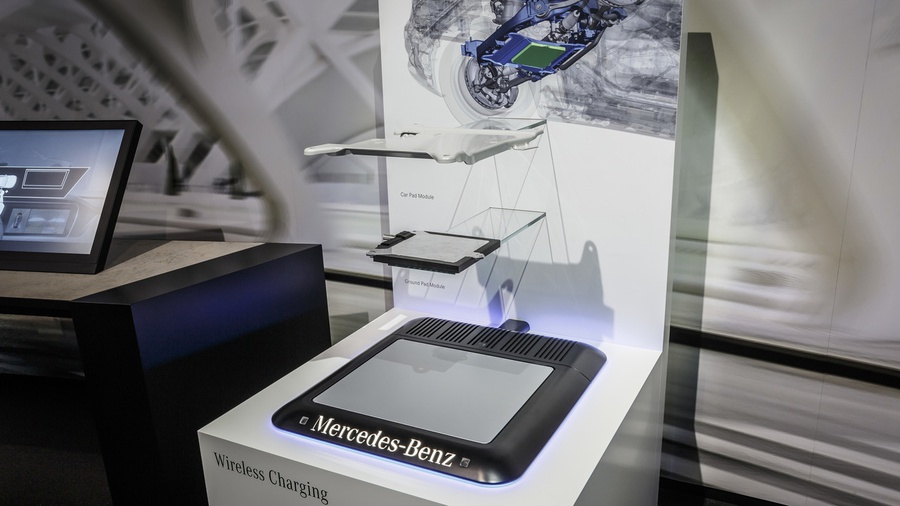Компания Mercedes-Benz испытывает индукционную зарядную систему на базе модели S-Class (S 500e) с 2015 года. На серийных автомобилях она будет предлагаться в качестве опции, в дополнение к стандартной зарядной системе. Ключевыми компонентами устройства является установленная в полу гаража или, например, паркинга, пластина-передатчик и приёмное устройство в полу машины. Сообщение о том, что автомобиль правильно расположен относительно зарядной установки будет выводиться на экран мультимедийной системы. При этом никаких дополнительных действий совершать не надо - если система подключена к сети, машина начнёт заряжаться автоматически. Выходная мощность установки составит до 3.6 кВт при коэффициенте полезного действия около 90 процентов.
Помимо этого в Mercedes-Benz сообщили, что обновлённый S500e получит увеличенный запас хода. На седан 2018 модельного года будут устанавливать модернизированные литий-ионные аккумуляторы ёмкостью 13.3 кВт⋅ч против нынешних 8.7 кВт⋅ч. По расчётам производителя запас хода гибрида исключительно на электрической тяге увеличится с нынешних 33 км до 50 км по европейскому испытательному циклу NEDC. В настоящее время такой S-Class оснащается 3.0-литровым битурбо V6 двигателем, электромотором и 7-ступенчатым “автоматом” 7G-TRONIC Plus. Суммарная отдача силовой установки достигает 449 л.с., максимальный крутящий момент - 650 Нм, паспортный расход бензина в комбинированном цикле - 2.8 л/100 км. В Германии Mercedes-Benz S 500e стоит столько же, сколько и обычный S 500 с 455-сильным мотором V8 - от 110.2 тысяч евро.
Также стало известно, что начиная с 2018 года подзаряжаемые гибриды и электромобили Mercedes-Benz будут оснащаться зарядными системами стандарта CCS (Combined Charging System) нового поколения. Соответствующие устройства поддерживают подключения четырёх типов: к однофазным источникам переменного тока, трёхфазным источникам переменного тока, зарядкам с постоянным током, а также высокомощным зарядкам постоянного тока. Это позволит машинам с электрическими и электрифицированными силовыми установками заряжаться на экспресс-станциях до 80% за 15-20 минут.
Whether at home via a wallbox, while shopping, at work or on the street: the possibilities for powering electric vehicles are already very diverse nowadays. Daimler will shortly be offering an innovative solution, particularly for charging at home: inductive charging is set to revolutionise charging convenience from 2017. The use of the technology is initially planned for the facelift model of the Mercedes-Benz S 500 e. News for cable-connected charging, too: from 2018, direct current charging based on the CCS (Combined Charging System) standard will gradually find its way into all electric vehicles from Mercedes-Benz. This will enable fast charging in public with much greater performance than is possible today.
One of the next steps on the road to the perfect electric vehicle and plug-in-hybrid is wireless charging. Inductive charging makes handling these vehicles even more convenient. Mercedes-Benz has been testing the contactless charging technology since 2015 with a test fleet of the current S 500 e. From 2017 the technology should be ready: with the facelift model of the S 500 e, the availability of an inductive charging system as an optional extra is planned, in addition to cable-connected charging. With this innovative technology, the electrical energy is contactlessly and safely transmitted via a magnetic field.
The system is comprised of two components: a secondary coil in the vehicle floor and a base plate with integrated primary coil. This is placed on the garage floor, for example, or in a protected area in front of a carport. Via a display message in the cockpit the driver can see whether the vehicle is in the tolerance range over the charging station. As soon as the charging position has been reached, charging automatically begins and is constantly monitored by the system. The electrical energy is transmitted contactlessly, without a charging cable, at a power output of up to 3.6 kW. With an efficiency rate of almost 90 percent, the high-voltage battery can be efficiently, conveniently and safely charged.
AC + DC = Combined Charging System (CCS)
Public fast charging is increasingly gaining in importance. In the past years, Daimler, in conjunction with other automotive manufacturers, has decisively advanced the development of the Combined Charging System into an open and universal charging system for electric vehicles. The system pursues the goal of unlimited, global e-mobility. It expands the existing technical standard for AC charging of electric vehicles with the capacity for DC fast charging. From 2018 direct current charging based on the CCS standard will gradually find its way into all electric vehicles from Mercedes-Benz. Depending on the vehicle and battery system, this enables a charging capacity of up to 150 kW at fast charging stations. Perspectively, the system also enables a charging capacity of up to 350 kW.
Agreement on the European socket standard simultaneously simplifies the development of an extensive fast charging network. In Germany, partners from business, politics and research are involved in the development of this infrastructure: in public projects such as "SLAM - Schnellladenetz für Achsen und Metropolen" (Fast Charging Network for Transport Axes and Metropolitan Regions) or "Schnellladen Berlin" (Fast Charging Berlin) the partners are driving forward the development of a fast charging network within Germany across all industries. The German government has just decided to support the further development of a nationwide network of fast charging and normal charging stations with 300 million euros.


.jpg)





